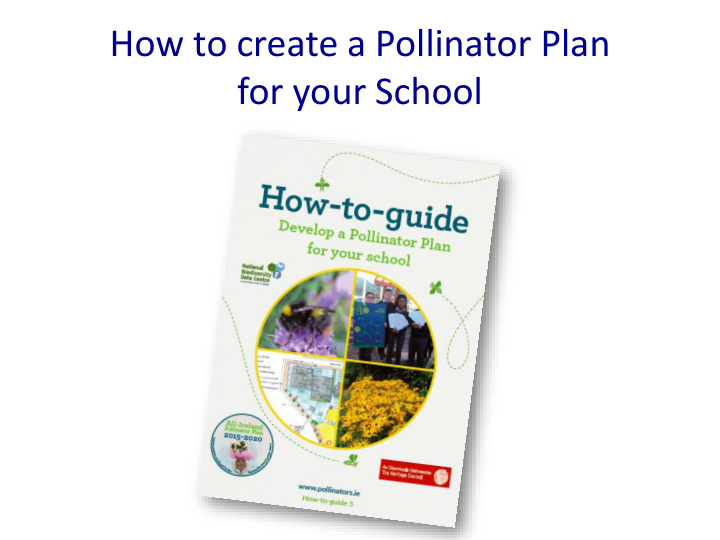



How to create a Pollinator Plan for your School
Protect what you have
Reducing mowing
Trees & Hedgerows
Pollinator-friendly planting
Provide nesting sites
Reduce pesticides Project: Eliminate pesticide completely and have a ‘weeding -by- hand’ day in the school in areas where weeds need to be removed
Record your actions
Links to the Primary School Curriculum One strand of the Primary Geography C urriculum is ‘Environmental awareness and care’. • It states that ‘By exploring the interrelationships of peoples and their environments, geography helps to promote knowledge about and concern and awareness of the potential of these environments’. • It also ‘places an emphasis on skills development through observing and exploring the richness of the immediate environs of the school and home. This involves the children in questioning, observing, experimenting and recording the features of the natural and human environments that they encounter’. A School Pollinator Plan can be used to teach these aspects of the curriculum.
ROI: Links to Post-primary Curriculum The new junior cycle has been developed as a new way of teaching all post- primary subjects. This incorporates not only subject knowledge by the development of 8 key skill and 24 statements of learning. The 7 th Statement of Learning is : ‘values what it means to be an active citizen, with rights and responsibilities in local and wider contexts’ The 10 th Statement of Learning is: ‘has the awareness, knowledge, skills, values and motivation to live sustainably’. Having a school pollinator plan encapsulates both these statements of Learning. It also develops the following Key Skills: • Staying Well • Being Creative • Communicating, • Working with others • Managing information & thinking.
The New Junior Cycle Science curriculum states that students should be able to: – conduct a habitat study; research and investigate the adaptation, competition and interdependence of organisms within specific habitats and communities. – evaluate how humans can successfully conserve ecological biodiversity and contribute to global food production; appreciate the benefits that people obtain from ecosystems. A School Pollinator Plan can be used to teach these aspects of the curriculum. The Leaving Certificate Biology Syllabus states that students should: – Show familiarisation with frequency and percentage cover techniques. – Outline one conservation practice from either agriculture, fisheries, or forestry. ( Could be used to explain Set-Aside) – Be able to identify of local ecological issues related to the selected ecosystem. – Be able to define and describe methods of “pollination”: self -pollination and cross-pollination, to include wind and animal. A School Pollinator Plan can be used to teach these aspects of the curriculum.
Increasingly, Schools are teaching Development Education which focuses on the 17 Sustainable Development Goals agreed by world leaders in an attempt to, by 2030: - End extreme poverty ; Fight inequality & injustice ; Tackle climate change. A pollinator plan could be used in the teaching of any of the following goals: – Zero hunger – Sustainable cities & communities – Responsible consumption and production – Life on land
www.pollinators.ie
Recommend
More recommend